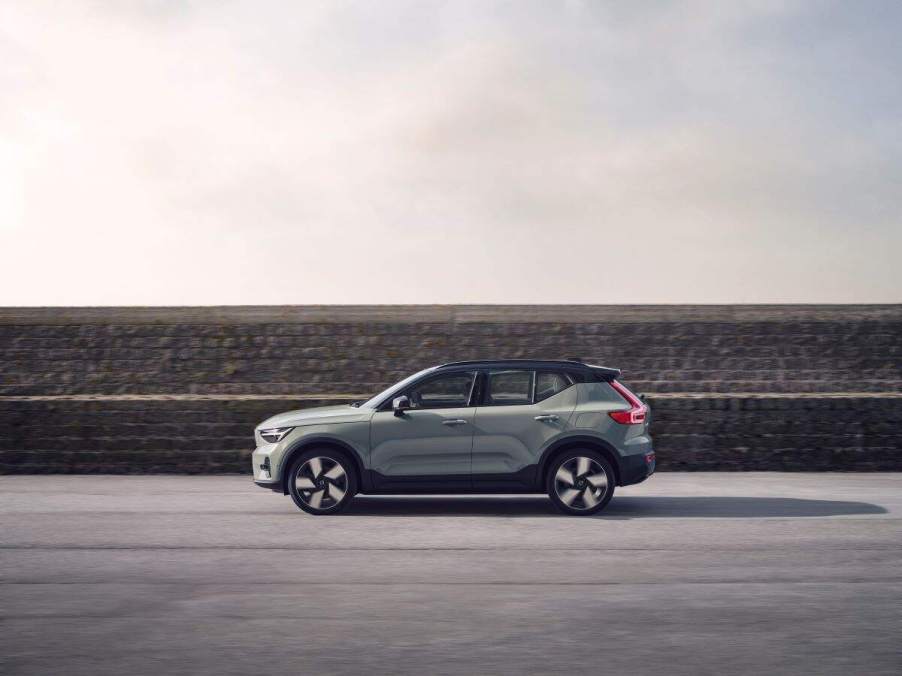
2 Reasons the Volvo C40 Is a ‘Tough Sell’
The luxury compact all-electric crossover segment has been rapidly picking up steam in recent years with models like the Mercedes-Benz EQB, BMW iX, Genesis GV60, and Audi Q4 e-tron joining the fray. Alongside those newcomers is Volvo’s C40 Recharge, the automaker’s all-electric and coupe-bodied take on the XC40 Recharge. The C40, which debuted for the 2022 model year, has some notable positives against its competition, but two major and negative sticking points make it a “tough sell.”

What holds the Volvo C40 back against its competition
Edmunds’ review of the 2022 C40 noted its most significant downsides are “shockingly poor” rearward visibility and its unimpressive driving range versus other models in its segment.
The poor rear visibility can be attributed to its coupe body style, which makes for an attractive package but one that can make turning at an oblique junction an exercise in faith. The dramatic slope of the roofline meets sharply raked rear glass and a bulky C-pillar, and rear visibility “suffers immensely” as a result, the publication said.
The C40 Recharge’s 226-mile driving range is also a flaw hidden underneath its attractive styling. For comparison, Tesla Model Y Long Range is priced similarly to the C40 and returned 317 miles of range through Edmunds’ testing.
The Volvo trails the Q4 e-tron’s 270 miles and the 242 miles offered by the Mercedes-Benz EQB. Even the Genesis GV60 Performance model returns an EPA-estimated 235 miles of range. It should be noted, the C40 returned 252 miles of range in Edmunds’ test, but even that over-achieving figure puts the model behind its rivals.
Edmunds said the C40’s lackluster rear visibility and subpar range will make it a “tough sell for buyers not enamored with the Scandinavian design aesthetic.” Still, not all is not lost for Volvo’s handsome EV.
The C40 still shines in some areas
Buyers who put a premium on design, standard all-wheel drive, quick charging times, comfort, and outright power could overlook the C40’s faults. And all it may take is a look. The C40’s fastback design, high waist and gently square-off front fascia make it a beauty on the outside, and handsome, minimalistic styling in the cabin furthers its attractiveness.
The C40 also provides plenty of umph with dual electric motors delivering 402 horsepower, 486 pound-feet of torque and a 0-60 time of 4.5 seconds, the latter making the Volvo quicker than the Model Y Long Range and the price-equivalent Ford Mach-E. Edmunds adds the C40 is “fun to whip around” with notable finesse, yet, it’s still “effortless to drive at any speed” with respectable body control.
The C40 Recharge will also recharge its 75-kWh battery from zero to 80 percent in under 40 minutes, which is competitive for its segment.
Edmunds also commended the C40 for its Google-driven infotainment system—though it did point out some gripes with the functionality—the spacious feel of its interior despite its small dimensions and the use of sustainable materials in the cabin, including its faux leather upholstery. The C40 is also fitted with a suite of active safety features with Volvo’s Pilot Assist semi-autonomous driving system.
Still, Edmunds noted some other gripes with the C40. The sloping roofline cuts down on rear passenger space and the cargo area, hurting its pragmatism, the rear view camera’s feed is partially blocked by bodywork, and it’s not a value proposition. The publication states the C40 doesn’t come any cheaper than the Model Y or Mach-E despite delivering less driving range.
Volvo has also been a bit of the left-field choice in the segments in which it competes, and that hasn’t necessarily held the brand back, so it remains to be seen if the C40’s blemishes will truly make it a “tough sell.”



